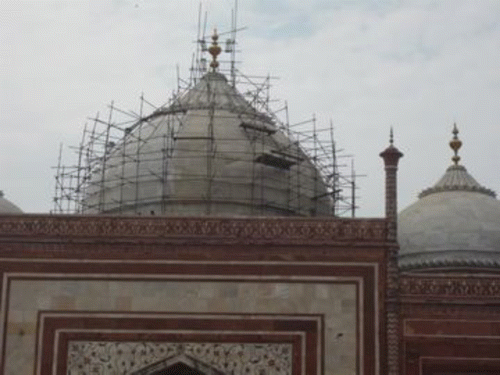What's in the grime tarnishing the Taj Mahal?

Every several years, workers apply a clay mask to India's iconic but yellowing Taj Mahal to remove layers of grime and reveal the white marble underneath. Now scientists are getting to the bottom of what kinds of pollutants are discoloring one of the world's celebrated wonders. Their findings, published in the ACS journal Environmental Science & Technology, could help inform efforts to protect the mausoleum and other surfaces from pollution.
Mike H. Bergin, Sachchida Nand Tripathi and colleagues note that Indian officials have tried to reduce the effects of pollution on the Taj Mahal by restricting nearby traffic and limiting local industrial emissions. But despite regulations and an occasional deep clean, the domes and minarets continue to accrue a layer of soot. So far, no published studies have looked closely at what specific compounds are causing it to appear yellow. Bergin's and Tripathi's teams wanted to find out.
The researchers analyzed particles in the air and on marble samples near the main dome over several months. Using a novel method they developed, the team estimated how these specks reflect light and therefore affect the color of the building. They conclude that black carbon and brown carbon from the burning of trash, fuels and other materials are among the primary pollutants tarnishing the Taj Mahal. In the future, their approach could be used to craft strategies to address the chronic yellowing and improve air quality, they say.
More information: "The Discoloration of the Taj Mahal due to Particulate Carbon and Dust Deposition" Environ. Sci. Technol., Article ASAP. DOI: 10.1021/es504005q
Abstract
The white marble domes of the Taj Mahal are iconic images of India that attract millions of visitors every year. Over the past several decades the outer marble surfaces of the Taj Mahal have begun to discolor with time and must be painstakingly cleaned every several years. Although it has been generally believed that the discoloration is in some way linked with poor air quality in the Agra region, the specific components of air pollution responsible have yet to be identified. With this in mind, ambient particulate matter (PM) samples were collected over a one-year period and found to contain relatively high concentrations of light absorbing particles that could potentially discolor the Taj Mahal marble surfaces, that include black carbon (BC), light absorbing organic carbon (brown carbon, BrC), and dust. Analyses of particles deposited to marble surrogate surfaces at the Taj Mahal indicate that a large fraction of the outer Taj Mahal surfaces are covered with particles that contain both carbonaceous components and dust. We have developed a novel approach that estimates the impact of these deposited particles on the visible light surface reflectance, which is in turn used to estimate the perceived color by the human eye. Results indicate that deposited light absorbing dust and carbonaceous particles (both BC and BrC from the combustion of fossil fuels and biomass) are responsible for the surface discoloration of the Taj Mahal. Overall, the results suggest that the deposition of light absorbing particulate matter in regions of high aerosol loading are not only influencing cultural heritage but also the aesthetics of both natural and urban surfaces.
Journal information: Environmental Science & Technology
Provided by American Chemical Society




















